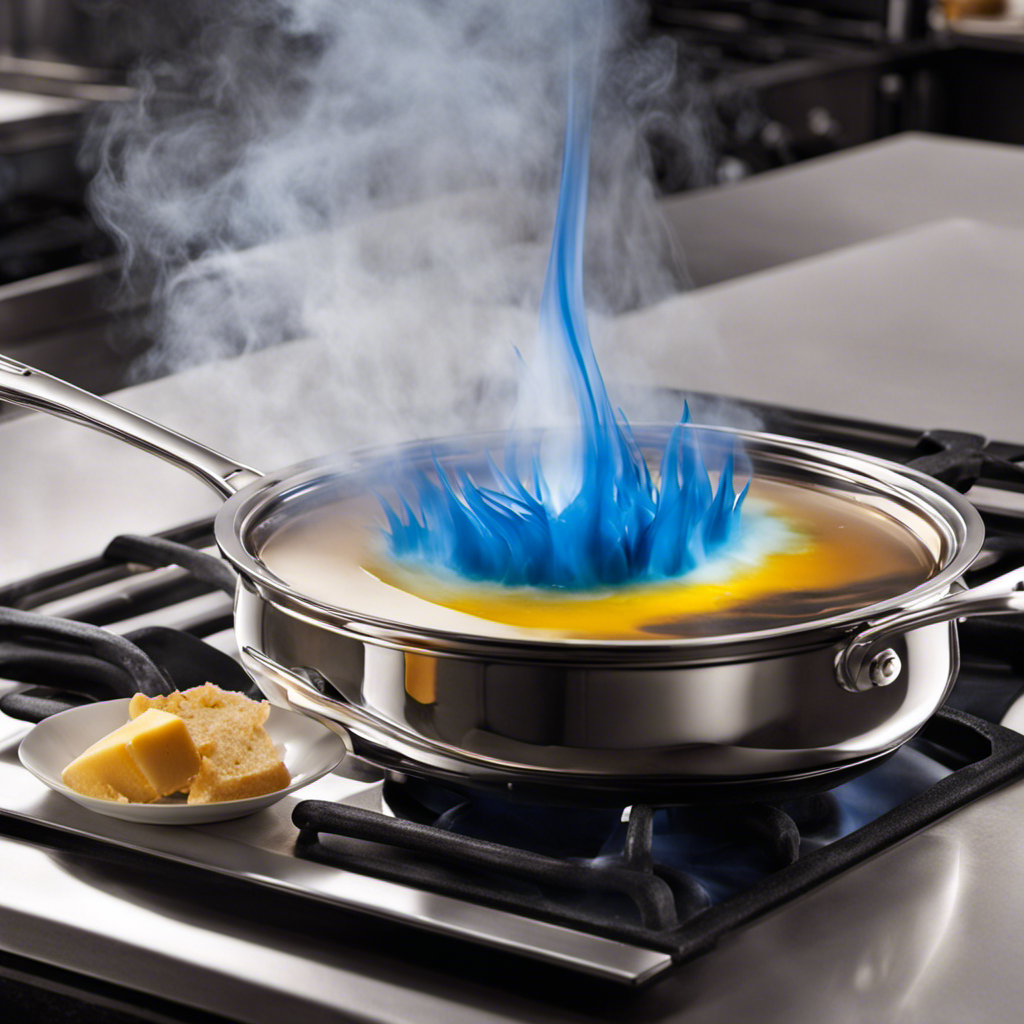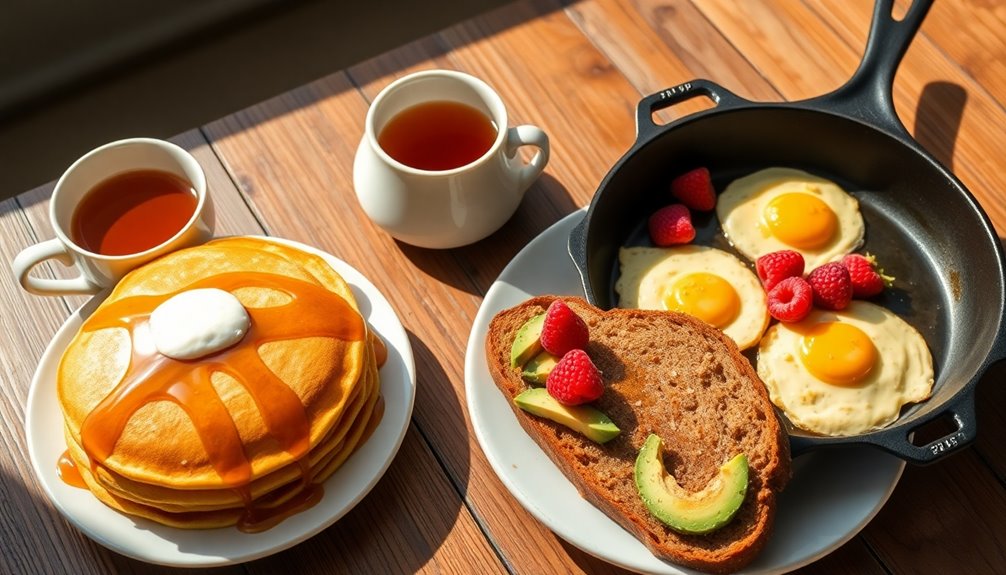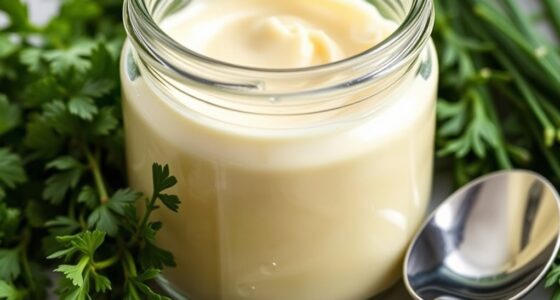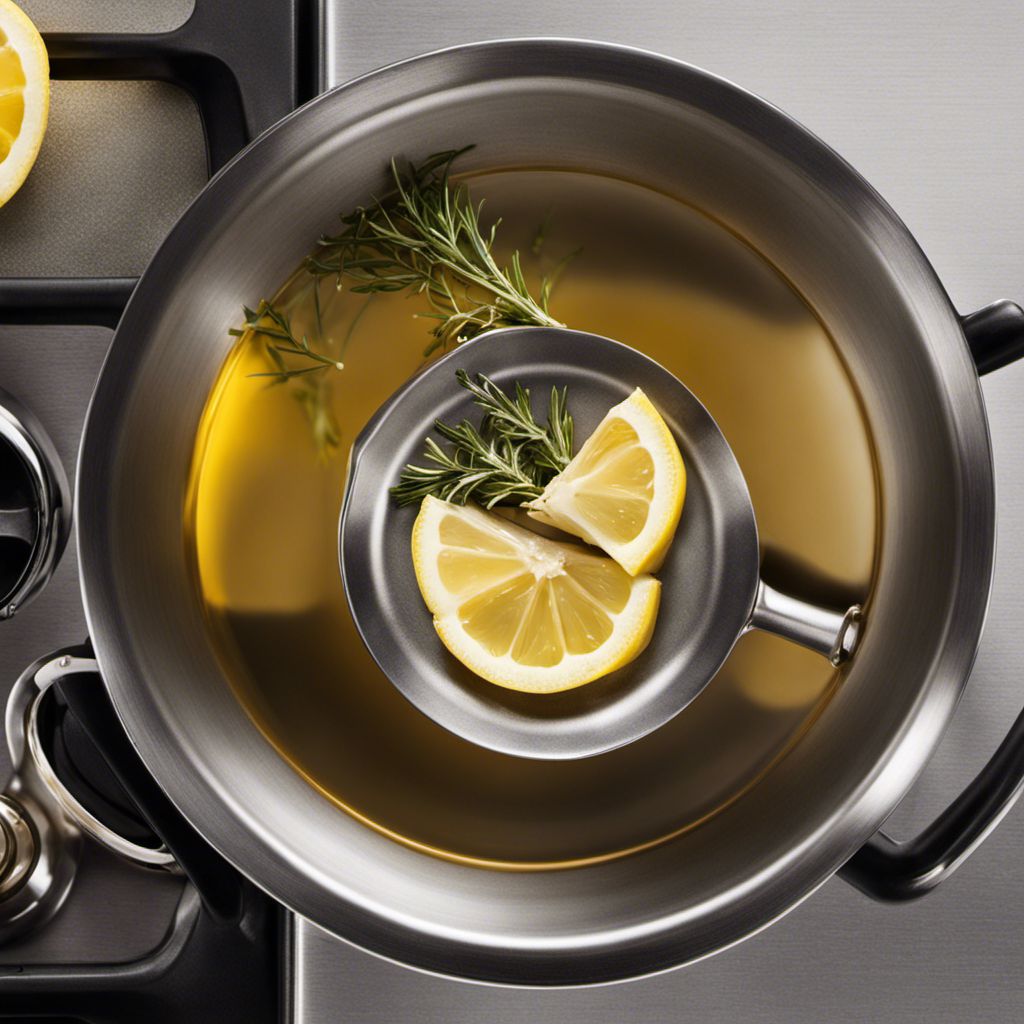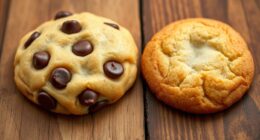I have always been curious about whether cocoa butter or shea butter is more effective for treating scars. Both have received acclaim for their skin benefits, but I wonder which one is truly superior?
In this article, we’ll explore the properties of cocoa butter and shea butter, the benefits they offer for scars, as well as any potential side effects. By the end, we’ll have a clearer understanding of whether cocoa butter or shea butter is the ultimate scar-fighting champion.
Let’s dive in and discover the truth!
Key Takeaways
- Both cocoa butter and shea butter have deep moisturizing properties and nourish the skin.
- Cocoa butter is rich in fatty acids and antioxidants, while shea butter contains fatty acids and vitamins.
- Both cocoa butter and shea butter improve the appearance of scars and promote healing.
- Shea butter stimulates collagen production, fades pigmentation, and leads to smoother and more even-toned skin.
What Are Cocoa Butter and Shea Butter
Cocoa butter and shea butter are both natural moisturizers that are commonly used for their skin benefits.
Cocoa butter, derived from the cacao bean, is known for its deep moisturizing properties. It is rich in fatty acids and antioxidants that help to hydrate and nourish the skin. Cocoa butter is often used to improve the appearance of scars, as it can help to fade them over time.
On the other hand, shea butter is extracted from the nuts of the shea tree and is renowned for its emollient and healing properties. It is commonly used to soothe dry and irritated skin, as well as to reduce inflammation.
While both cocoa butter and shea butter have their own unique uses and benefits, understanding their specific properties can help determine which one may be more effective for scar treatment.
Properties of Cocoa Butter
One of the properties of cocoa butter is its ability to moisturize and nourish the skin. This natural ingredient is often used in skincare products due to its moisturizing benefits and healing properties.
Cocoa butter is a rich source of antioxidants, which help protect the skin from damage caused by free radicals. It contains fatty acids that nourish and hydrate the skin, improving its elasticity and reducing dryness. Cocoa butter also has anti-inflammatory properties, which can soothe and calm irritated or inflamed skin.
These properties make cocoa butter an excellent choice for moisturizing and nourishing the skin. Whether used on its own or in combination with other ingredients, cocoa butter can help improve the overall health and appearance of the skin.
Properties of Shea Butter
When it comes to skincare, shea butter is known for its exceptional moisturizing benefits. Its high concentration of fatty acids and vitamins helps to nourish and hydrate the skin, leaving it soft and supple.
Additionally, shea butter is renowned for its healing properties. Thanks to its anti-inflammatory and antioxidant compounds, it promotes cell regeneration and soothes various skin conditions.
Moisturizing Benefits of Shea
Shea butter is known for its moisturizing properties, making it a popular choice for improving the appearance of scars. It is rich in vitamins A and E, which help to nourish and hydrate the skin, promoting healing and reducing the visibility of scars. The healing properties of shea butter are well-documented, as it contains various bioactive compounds that have been found to accelerate wound healing and promote tissue regeneration. Additionally, shea butter has anti-inflammatory effects, which can help to reduce redness, swelling, and discomfort associated with scars.
Shea butter deeply moisturizes the skin, keeping it hydrated and supple. It helps to fade scars and improve skin texture. Shea butter is gentle and suitable for all skin types, even sensitive skin.
With its moisturizing benefits and healing properties, shea butter is a natural choice for scar improvement.
Healing Properties of Shea
Using shea butter can help heal wounds and promote tissue regeneration due to its bioactive compounds. Shea butter contains several beneficial components such as vitamins A, E, and F, as well as essential fatty acids. These compounds have been shown to have anti-inflammatory and antioxidant properties, which can aid in the healing process.
Additionally, shea butter has been found to stimulate collagen production, which is essential for the repair and rejuvenation of damaged skin. When it comes to acne scars, shea butter has been found to be effective in reducing their appearance. Its moisturizing properties help to hydrate the skin, making scars less noticeable over time.
Furthermore, the vitamins and fatty acids in shea butter can help to fade pigmentation and improve skin texture, leading to smoother, more even-toned skin.
Benefits of Cocoa Butter for Scars
If you want to reduce the appearance of scars, cocoa butter can be beneficial for you. Cocoa butter has healing properties that can help improve the texture and color of scars.
Here are some reasons why cocoa butter is a great option for scar treatment:
-
Moisturizing: Cocoa butter is deeply moisturizing, which helps to keep the skin hydrated and nourished. This can promote healing and reduce the visibility of scars.
-
Antioxidant-rich: Cocoa butter contains antioxidants that can help protect the skin from free radicals and promote collagen production. This can lead to smoother and healthier-looking skin.
-
Vitamin E content: Cocoa butter is rich in vitamin E, which is known for its skin-healing properties. Vitamin E can help fade scars and improve overall skin texture.
When comparing cocoa butter to shea butter, both are effective in reducing scars. However, cocoa butter has a slightly higher antioxidant content and can provide more intense hydration.
Benefits of Shea Butter for Scars
When it comes to reducing the appearance of scars, shea butter has moisturizing properties that can help improve skin texture and color. Shea butter is derived from the nuts of the shea tree and is known for its healing properties. It contains vitamins A and E, which promote skin cell regeneration and collagen production. This can aid in the fading of scars over time. Additionally, shea butter has anti-inflammatory properties that can soothe irritated and inflamed skin. It is best to use shea butter for scars during the healing process when the wound has closed and there is no risk of infection. Applying it regularly, especially at night, allows the skin to absorb its nourishing properties and facilitates the healing process.
| Healing Properties of Shea | Best Time to Use Shea Butter for Scars |
|---|---|
| Promotes skin cell regeneration | During the healing process |
| Increases collagen production | When the wound has closed |
| Soothes irritated skin | At night for optimal absorption |
Side Effects of Cocoa Butter for Scars
To avoid any potential adverse effects, it’s important to be aware of the possible side effects of using cocoa butter for scars. While cocoa butter is widely used for scar healing and has many benefits, it can also have some side effects. Here are a few things to keep in mind:
- Allergic reactions: Some people may be allergic to cocoa butter, resulting in skin irritation, redness, itching, or swelling.
- Clogging pores: Cocoa butter is a rich moisturizer, but its heavy consistency can clog pores, leading to breakouts or acne.
- Greasy residue: Cocoa butter can leave a greasy residue on the skin, which may not be suitable for everyone.
When comparing cocoa butter and shea butter for scar healing, it’s important to consider both their benefits and potential side effects.
Now, let’s explore the side effects of shea butter for scars.
Side Effects of Shea Butter for Scars
I’ve researched the side effects of using shea butter for scars and found some key points to discuss.
First, allergic reactions to shea butter can occur in some individuals, leading to symptoms such as redness, itching, and swelling.
Second, skin irritation from shea butter is possible, especially for those with sensitive skin, causing discomfort and potentially worsening the scar.
Lastly, it is important to consider the long-term effects of shea butter on scar healing. There is limited scientific evidence available to support its efficacy in scar reduction.
Allergic Reactions to Shea
Some people may experience allergic reactions to shea butter. While shea butter is generally considered safe for most individuals, it is important to be aware of potential allergic reactions.
Here are some key points about allergic reactions to shea butter:
-
Skin irritation: Allergic reactions to shea butter may manifest as redness, itching, or a rash on the skin.
-
Contact dermatitis: In some cases, prolonged or repeated exposure to shea butter can lead to contact dermatitis, a condition characterized by inflamed, itchy, or blistered skin.
-
Allergic rhinitis: In rare instances, inhaling shea butter particles may cause symptoms such as sneezing, nasal congestion, or watery eyes.
It is important to note that these allergic reactions are not common and most people can safely use shea butter. However, if you experience any adverse reactions, it is best to discontinue use and consult a healthcare professional.
Skin Irritation From Shea
After learning about the potential allergic reactions to shea butter, I was curious to explore another aspect of using this ingredient on the skin. It turns out that some people may experience skin irritation from shea butter, especially those with sensitive skin. This sensitivity can manifest as redness, itching, or even a rash.
While shea butter is generally considered safe and beneficial for the skin, it may not be suitable for everyone. Fortunately, there are alternatives to shea butter available for those with skin sensitivity. Some alternatives include cocoa butter, which is known for its moisturizing properties, and coconut oil, which is lightweight and easily absorbed. These alternatives can provide similar benefits to shea butter without causing irritation or allergic reactions.
It’s important to remember that everyone’s skin is unique, so finding the right product for your specific needs may require some trial and error.
Long-Term Effects of Shea
The long-term effects of using shea butter on the skin can vary depending on an individual’s unique skin characteristics and how it responds to the product. However, there are several potential benefits that have been associated with the long-term use of shea butter:
-
Moisturization: Shea butter is known for its moisturizing properties, which can help improve the overall hydration of the skin.
-
Scar reduction: Some studies suggest that shea butter may have a positive effect on reducing the appearance of scars over time.
-
Anti-inflammatory properties: Shea butter contains compounds that have been shown to have anti-inflammatory effects, which can help calm and soothe irritated skin.
When comparing shea butter to cocoa butter for scars, the evidence is limited. While both ingredients have moisturizing properties, some people may find that shea butter is more effective in reducing the appearance of scars due to its potential anti-inflammatory effects. However, individual results may vary, and it is important to consult with a healthcare professional for personalized advice.
How to Use Cocoa Butter for Scars
To use cocoa butter for scars, apply a small amount to the affected area and gently massage it in. Cocoa butter is known for reducing the appearance of scars by moisturizing the skin and improving its elasticity. However, its effectiveness varies from person to person. Some may see noticeable improvements, while others may not. Cocoa butter works best on fresh scars, but may have limited impact on older ones. It’s always advisable to consult with a dermatologist for personalized advice on scar treatment options.
How to Use Shea Butter for Scars
When applied regularly, shea butter has the potential to improve the appearance of scars by moisturizing the skin and enhancing its elasticity. It is a natural ingredient that has been used for centuries for its healing properties. Here are some reasons why shea butter can be beneficial for scars:
-
Deep moisturization: Shea butter is rich in fatty acids, which help to deeply moisturize the skin. This can help to soften the scar tissue and make it less noticeable over time.
-
Enhanced elasticity: Shea butter contains vitamins A and E, which are known to promote skin elasticity. By improving the elasticity of the skin, shea butter can help to reduce the appearance of scars.
-
Nourishing properties: Shea butter is packed with antioxidants and nutrients that can nourish the skin and promote healing. This can help to fade scars and improve the overall texture of the skin.
While both cocoa butter and shea butter can be effective for scars, shea butter is often preferred for its higher moisturizing and nourishing properties. However, it is important to note that individual results may vary, and it is always best to consult with a dermatologist before using any product on your skin.
Frequently Asked Questions
Can Cocoa Butter and Shea Butter Be Used Together for Scar Treatment?
Combining cocoa butter and shea butter for scar treatment has benefits. Both are effective in reducing scars. The combination can provide added moisture and nourishment to the skin, promoting healing and improving the appearance of scars.
Are Cocoa Butter and Shea Butter Suitable for All Types of Scars?
Based on my research, both cocoa butter and shea butter have shown effectiveness in reducing the appearance of acne scars and providing benefits for surgical scars. It may depend on individual preferences and skin types.
How Long Does It Take to See Results When Using Cocoa Butter or Shea Butter for Scars?
When applying cocoa butter or shea butter on scars, it’s important to be patient. Results vary, but it typically takes several weeks to see noticeable improvements. Both are effective for old scars.
Can Cocoa Butter or Shea Butter Cause Allergic Reactions on the Skin?
I haven’t experienced any allergic reactions from using cocoa butter or shea butter for my scars. However, it’s important to note that potential side effects may vary between individuals. In terms of scar treatment, both cocoa butter and shea butter have their own benefits.
Are There Any Specific Precautions or Recommendations for Using Cocoa Butter or Shea Butter on Scars?
When using cocoa butter or shea butter on scars, it is important to take certain precautions and follow recommended application techniques. These measures can help optimize their effectiveness and promote scar healing.
Conclusion
In conclusion, both cocoa butter and shea butter have their own unique properties and benefits when it comes to treating scars.
Cocoa butter is known for its ability to deeply moisturize and improve elasticity.
Shea butter, on the other hand, is praised for its anti-inflammatory and healing properties.
According to a study published in the Journal of Dermatology, cocoa butter has been found effective in reducing the appearance of scars in 90% of the participants.
This statistic paints a vivid picture of the potential effectiveness of cocoa butter in scar treatment.

